AFFILIATE MARKETING
How This 45-Year-Old Sold 2 Sites for Mid Six-Figures Thanks to SEO and Email Marketing

She started off with a homeschool e-commerce store, followed by a blog to drive traffic to her store. Much to her surprise and delight, her blog income quickly surpassed her e-commerce income.
Carrie went on to create two more sites from scratch: one to sell homeschool bundles and one to sell homeschool resources that she created and self-published, called Daily Skill Building.
Last year, she also took over the blog of a late friend of hers in the healthy eating and living space called My Big Fat Grain Free Life.
Along the way, she used unique approaches to grow her traffic and increase her revenue, and she perfected the art of email marketing, nurturing a very lucrative list to 200k subscribers.
Carrie sold 3 of her sites, 2 of them for mid-six figures each. She has developed a passion for flipping businesses and, over the last 20 years as an entrepreneur, she has gained a wealth of knowledge.
Keep reading to find out:
- What type of e-commerce store she originally opened
- How she grew her homeschool blog
- How she grew her bundles website
- How she created her store with her own homeschool resources
- How she has progressed with her healthy living and recipe site
- What happened when she sold her first e-commerce site
- How the sales of her bundle site and homeschool blog went
- Her main marketing strategies
- Her thoughts on SEO
- Her approach to keyword research and link building
- How she creates content
- How she grows her email lists
- The resources and tools she uses in her business
- Her main challenge
- Her greatest accomplishment
- Her biggest mistake
- Her advice for other entrepreneurs
Meet Carrie Fernandez
In 2004, I made the decision to leave behind my corporate life after years of working in the real world since the age of 14. My motivation for this change was to care for our toddler while helping my husband with his web design and programming business.
During this time, I took on the challenge of learning how to design websites and all the related skills to assist him, which unexpectedly sparked my interest in starting an online business.
With a strong background in retail management and a genuine passion for that type of work, I ventured into the world of e-commerce in 2009.
This marked the beginning of my journey as an entrepreneur, creating opportunities to combine my skills and interests into a thriving online venture.
Why She Created Her Sites
Armed with my newly acquired web design skills, I set up an e-commerce store in 2009 where I offered homeschool curriculum as a dropshipper.
I created an e-commerce store for homeschooling curriculum because it provided me with the opportunity to purchase curriculum at a discounted rate through a distributor. As a homeschooling mom myself, this was quite advantageous.
Initially, I had no expectations of profitability; my primary goal was simply to establish an online presence in order to become a retailer.
At that time, there existed a prominent distributor who allowed me to purchase products at wholesale prices and handle direct shipping to my customers. Regrettably, this distributor has since ceased its operations.
This all led me to create a blog specifically focused on the homeschooling community in 2011. This blog served as a powerful marketing tool for my curriculum store.
To my surprise and delight, within just two years, the income generated from my blog surpassed that of my e-commerce store. Pinterest was my #1 traffic source during this period.
My First E-commerce Store: 2009-2013
In order to obtain discounted curriculum for my own personal use, I established my first e-commerce store and secured a wholesale account with a large distributor. To my surprise, this e-commerce store turned out to be profitable!
Despite having no marketing budget, I employed creative strategies such as giveaways and leveraging social media platforms to promote my store. My primary focus was on expanding my newsletter subscriber base and nurturing those relationships with customers.
In 2011, I made the decision to launch a homeschool blog solely for the purpose of marketing my curriculum store.
The success of my e-commerce store can largely be attributed to offering lower prices compared to competitors.
However, this came at the expense of thin profit margins due to the manual processing required for each order. It became evident that I found greater fulfillment in investing time into my blog instead.
My Homeschool Blog: 2011-2023
When I first started my homeschool blog, it was initially intended as a marketing tool for my e-commerce site. I would write reviews of the curriculum that I sold and host giveaways to grow my newsletter list.
As someone who had experience with various homeschool publishers through my e-commerce store, I decided to collaborate with them to offer reviews and giveaways on my blog.
It was during this time that I came up with the idea of providing exclusive sponsored freebies to my subscribers, which I sourced through my connections in the homeschool industry. At that point, my subscriber list had grown to 200,000!
At that point in time, as I hadn’t started creating my own products yet, but I collaborated with other publishers and bloggers who did.
For a fee, I would provide their resources to my subscribers for free, but only for a brief period of time, never exceeding a week. It was made clear to the subscribers that by opting in for the free download, they would be added to both the sponsor’s list and mine if they weren’t already subscribed.
This proved to be highly beneficial for my sponsors as it resulted in up to 10,000 people opting in for the free offer and expanding their subscriber base. For me, it served as an effective method of driving traffic and increasing ad earnings.
At its peak, my homeschool blog had a team of eight writers. It evolved into a platform similar to a daily deals site for homeschoolers where we shared freebies, giveaways, and special offers related to homeschooling.
Initially, our main source of traffic was Pinterest as it sent us most of our visitors. However, when Pinterest made changes that caused many bloggers to lose a significant portion of their traffic overnight, including myself, I realized the importance of learning about SEO.
From that point onwards (mid-2021), I made it my mission to learn SEO strategies and became completely absorbed in mastering them.
I switched to an SEO focus in July of 2021, at which time my homeschool blog was indexed for around 35,000 keywords. By spring of 2023, my homeschool blog was indexed for over 115,000 keywords.
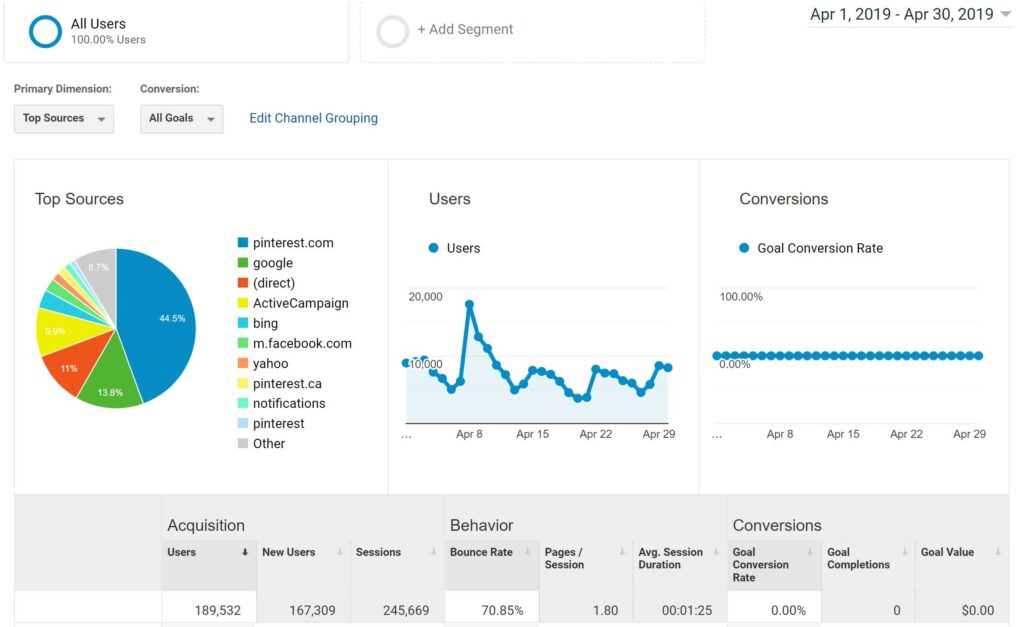
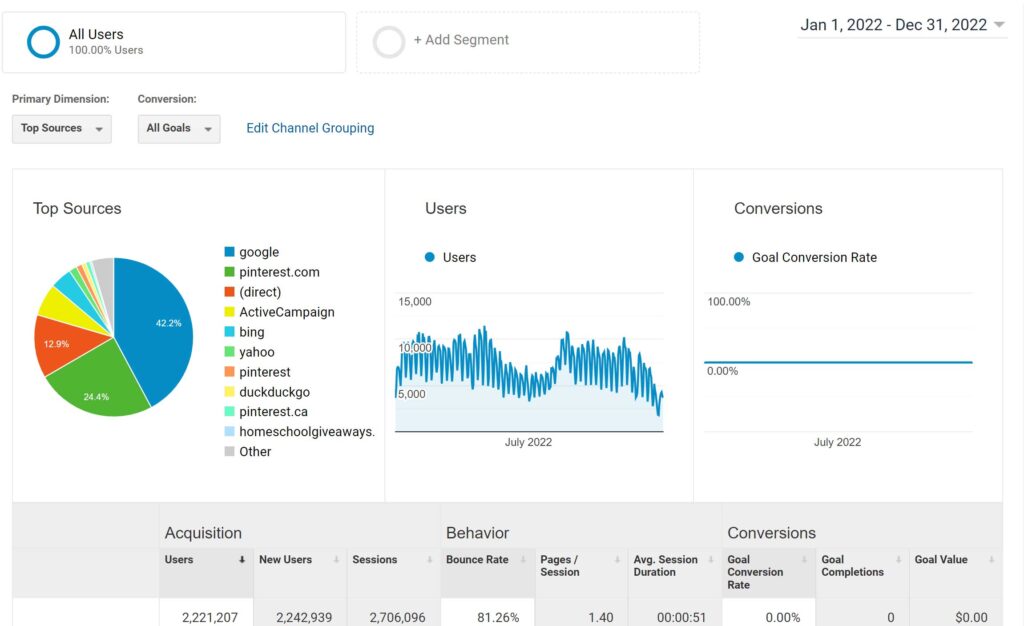

Build Your Bundle: 2014-2018
In 2014, I decided it was time to start another business in the homeschool space, and Build Your Bundle was born. This was during a time when bundle sales were very popular for customers and profitable for business owners.
There was only one homeschool bundle sale at the time and they wouldn’t allow me to participate as an affiliate because I wasn’t a part of their network, so this was my response to them.
To create a unique offering in the homeschool market, I developed Build Your Bundle with a different approach compared to other bundle sales.
Recognizing that homeschooling is a distinct niche, I wanted to provide customers with more flexibility and choice. With Build Your Bundle, individuals could hand-pick the resources they want included in their personalized bundle.
Daily Skill Building 2019-Current
In 2018, I introduced my first product on my homeschool blog and continued to develop and self-publish additional resources.
With the goal of eventually selling my homeschool blog, I made the decision to move my shop from the blog onto its own dedicated website, an e-commerce store. This led to the establishment of Daily Skill Building in 2019.
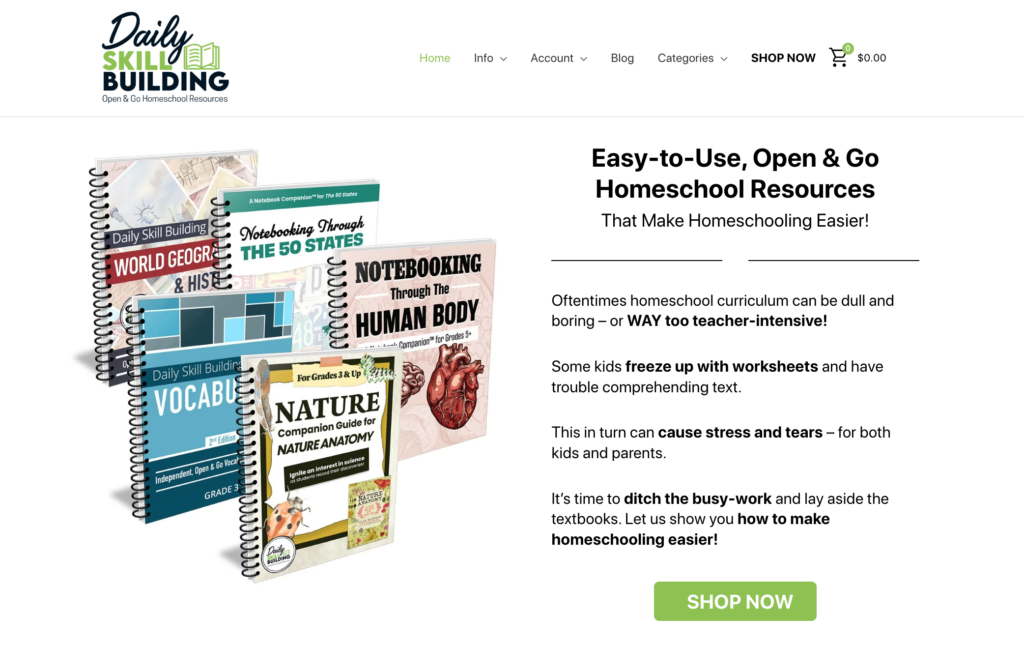

At that time, my primary method of marketing was through my homeschool blog, which received between 300,000-500,000 monthly page views, depending on the season.
Additionally, I had built a large newsletter list consisting of homeschooling families, providing me with a significant audience for marketing purposes.
Fast forward to today, we now offer over 100 different resources that we self-publish. The majority of our products are available in digital format only; however, we do have nine titles that are also available in print.
My Big Fat Grain Free Life 2023-Current
In April 2023, I had the opportunity to take over my late friend Jen’s blog, My Big Fat Grain Free Life. Previously a personal project for Jen to share recipes and life updates with loved ones, I saw potential in transforming it into something more.
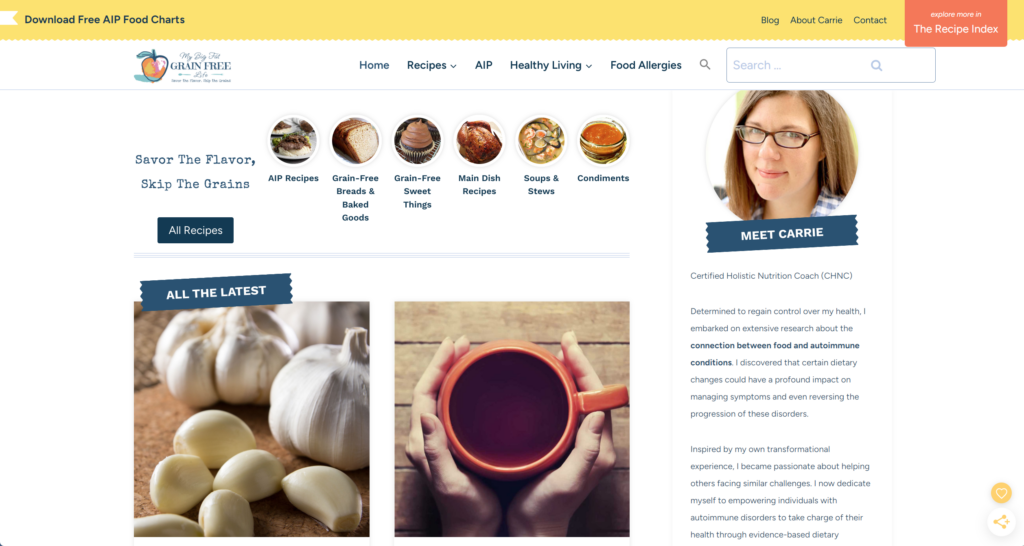

With a focus on SEO, my goal was to make the blog a valuable resource in the realm of healthy living through nutritious foods.
Upon taking over, the blog had 2,000 monthly sessions but required significant updates and improvements.
To start, I saved the entire site in PDF format as a keepsake for Jen’s family. Then, I conducted a thorough site audit and removed any personal stories that did not rank for keywords or have backlinks.
In order to track progress effectively, I created a spreadsheet that documented each URL’s indexed keywords, backlinks, and best keyword positions. Posts without backlinks or indexed keywords were deleted while recipes were saved for future use.
With the blog now cleaned up and streamlined, I focused on the design and page speed and changed the logo and theme. Since April 2023, I have updated 57 posts and published an additional 125 new ones.
Much to my delight, just nine months after taking over the blog, its monthly sessions went from 2,000 to over 60,000!
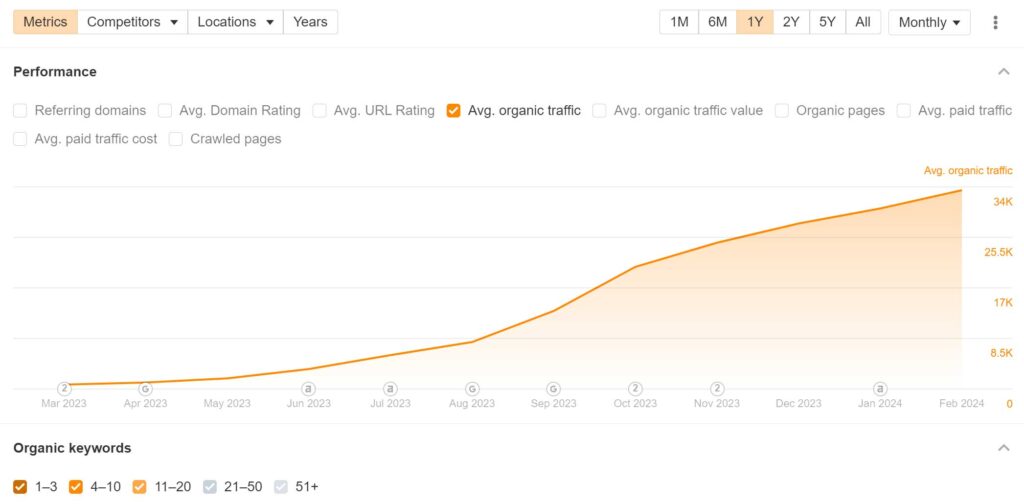

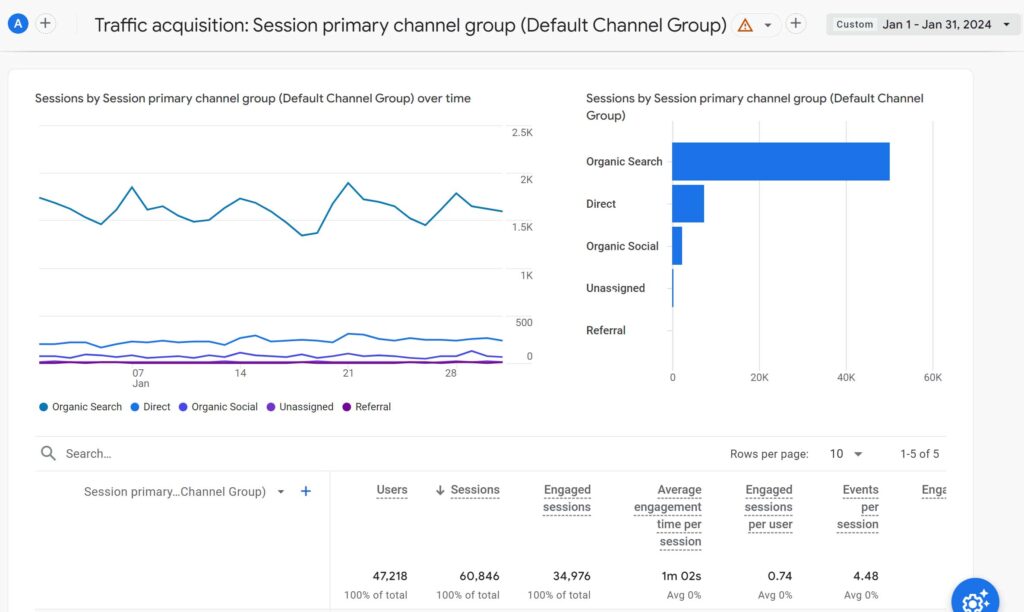

I applied to Mediavine and went live with ads in February.
Timeline of events:
- In 2009, I started my first online company. It was an e-commerce drop-shipping company selling homeschool curricula.
- In 2011, I started my homeschool blog. Within two years it exceeded the income of my e-commerce site.
- In 2013, I sold my e-commerce site.
- In 2014, I started Build Your Bundle with a business partner. This company was a once-per-year, week-long bundle sale in the homeschool space.
- In 2018, we sold Build Your Bundle.
- In 2019, I started Daily Skill Building and moved the products off my homeschool blog. This site grew fast and was catching up to the income I made from my homeschool blog.
- In April of 2023, I acquired my deceased friend’s food blog from her husband (My Big Fat Grain Free Life) which had been sitting for several years.
- In July of 2023, I sold my homeschool blog.
When it comes to working on my sites, I work Monday to Friday for about 6 to 8 hours a day.
Selling My First E-commerce Store (2013)
In 2013, I made the decision to sell my ecommerce store, which was generating a profit of around $40,000 per year. The reason behind this choice was that the business lacked automated order processing and every order had to be manually handled.
It required a significant amount of effort, especially considering our low profit margins ranging from 5-7%. To alleviate some of the workload, I hired a homeschool mom friend to process the orders.
However, due to the low profit margins, it became more burdensome than it was worth, especially when compared to the higher earnings from my homeschool blog, which required less effort.
Eventually, I sold the ecommerce store for $150,000 to another company within the homeschool industry. Looking back, there were a couple of mistakes I made during this process.
The first mistake I made was not using a broker to handle the sale. Secondly, we allowed owner financing. We received a deposit of $40,000 and agreed on monthly installments of $3,055 for three years to complete the payment.
Unfortunately, things took an unfortunate turn when the purchasing company not only defrauded our wholesaler by almost $30,000, but also stopped making their monthly payments altogether. This left us with an outstanding balance of $50,000.
To assess our options and potential recourse in this situation, we sought legal advice and had an assets check performed on the new owners of our company.
It turned out that they were heavily in debt and had no means of repayment or assets that could be recovered. Consequently, we had no choice but to write off this loss and move forward.
Selling Build Your Bundle (2018)
Build Your Bundle was established as an exclusive annual sale, available for just one week. Crafting this event to maximize profitability within that limited timeframe was an immense undertaking, requiring our dedicated team of six to invest approximately six months of the year working on it.
The magnitude and stress associated with operating a website with such a short sales window took a toll on my personal health.
However, despite the challenges, Build Your Bundle proved to be highly profitable. Keep in mind that all revenue was generated during the single week of our sale.
In our first year, we made a net profit of $45,290; in the second year, it rose to $109,689; in the third year, it reached $123,717; and in our final year, we achieved a profit of $148,100.
Having learned from the disaster we faced during our first sale, we decided to enlist the services of Quiet Light Brokerage to handle the sale of Build Your Bundle. This process was thorough and involved expert guidance every step of the way.
Chuck Mullins served as our dedicated representative and did an exceptional job. As far as I know, he is still with the company, and I highly recommend his services.
Quiet Light Brokerage provided a concierge-like experience throughout the entire process and even participated in calls alongside us when engaging with potential buyers.
Ultimately, after approximately one month on the market, we successfully sold the website for a substantial six-figure sum. Specific details are subject to contractual confidentiality.
Selling the Homeschool Blog (2023)
My blog generated a diverse range of income streams. One of my main sources was through the sale of dedicated eblasts to my large subscriber list, which ranged from 150,000 to 200,000 subscribers.
Each send of these eblasts made $3,000!
Additionally, I sold banner ads, reviews, sponsored posts, giveaways, and social media marketing to further monetize my blog.
I booked sponsored eblasts on Tuesdays and Thursdays and the frequency varied based on the season. Homeschooling has quite a bit of seasonality.
Sponsors would provide the HTML content for their campaign, and I added a disclaimer to the top and bottom of the emails.
Initially, I partnered with AdThrive (now Raptive), but after a few years, I transitioned to Mediavine and experienced increased RPMs.
The last five years of owning my blog, I earned an average monthly income of $18,000. This revenue breakdown is as follows:
- Advertising packages: 35% (combination of sponsored posts, dedicated eblasts, web banners, reviews, etc.)
- Dedicated eblasts: 31%
- Ad earnings: 25%
- Affiliate income: 5%
- Website banners: 2%
- Miscellaneous: 2% (social media marketing, sponsored posts, giveaways, sponsored freebies, etc).
I decided to sell the blog at the beginning of the year in 2023 and started the process of preparing the site for a new owner.
This time I used Motion Invest, since I was such a fan of Spencer’s, and he recommended it. It was a much different process than using Quiet Light, and I was a bit surprised at the lack of involvement from them.
I will admit, it was a much easier process to get listed, and since I had sold two sites previously, I wasn’t very concerned about doing the negotiations on my own.
In less than 30 days I had found the perfect buyer! My homeschool blog sold for mid-six-figures.
Right now I’m working on my new-to-me food/healthy living blog, My Big Fat Grain Free Life, and my homeschool curriculum publishing company, Daily Skill Building.
At the time of writing this, my food blog gets around 60k monthly sessions. I haven’t focused much on SEO for Daily Skill Building, mostly because I haven’t quite figured out how to nail SEO for product descriptions yet.
My blog posts on that site rank well though!
Her Top Marketing Strategies
My number one marketing strategy is my list!
Newsletter lists can be very lucrative, and building relationships with your subscribers is key.
I currently have around 20,000 subscribers for Daily Skill Building and just under 1,000 for My Big Fat Grain Free Life, for which the list is about 6 months old. I also utilize Facebook ads for Daily Skill Building.
As for my success with my other lists, I made it a point to send emails to my subscribers every Monday and Wednesday, featuring free homeschool resources.
In each email, I would share a personal story or message at the beginning, creating a sense of connection and relatability.
I also encouraged my subscribers to engage with me by inviting them to reply with any questions they had. By doing so, my subscribers felt like they knew me on a personal level.
To further encourage engagement, I offered monthly rewards based on engagement. Those who remained actively engaged throughout the month by opening emails and clicking links were eligible to receive an exclusive freebie.
To streamline the process, I used automation to tag and identify engaged subscribers easily.
Her Thoughts on SEO
I have focused 100% on SEO for My Big Fat Grain Free Life. I write about what interests me, but I heavily research the keywords before writing.
I use the RankIQ keyword library for low-competition, high-volume keywords and do my own research to find keywords that I want to write about.
I tend to also fly by the seat of my pants, so if I get in the mood to write a specific type of post, I may veer off my content calendar and just go for it.
Keyword Research
I start out by searching the term I’m interested in and looking at the domain authority of the blog posts that show up on page one of the SERPs.
If the DAs are in range of mine, or there is at least one lower-range DA in the results, I grab the URL of the top-ranking, non-sponsored post and analyze it using Ahrefs.
I glance through the keywords and look at the traffic it’s bringing in. If the keyword difficulty score is in the green and there is good enough traffic potential, I then look at the comprehensiveness of the top ten posts in the SERPs to see if I can write something better or from a different angle.
If I would only be regurgitating all the exact same info as the other posts that already rank, I skip it and move on.
If I determine that information is lacking for the posts that show up in the SERPs, I run a report in RankIQ for my chosen keyword.
It’s important to note that the Ahrefs keyword difficulty score is not a metric that I really trust; instead, I rely on what RankIQ tells me.
If I run the report and the difficulty score is out of my range, I do not proceed. If the RankIQ report shows acceptable keyword difficulty, I begin the next step, which is outlining the post for the target keyword.
Link Building
I have never spent time or money on acquiring backlinks, I’ve just let them happen naturally, but I am huge on internal linking!
As I’m writing posts or approving pending posts from an author, I add links into the content naturally.
Before I sold my homeschool blog, there were several thousand posts, so Link Whisper was helpful with that. I still use Link Whisper for my food blog, but I don’t have to rely on it as much since I know my content.
Another thing I do is make sure that all new posts have at least one internal link going to them, but usually a few, right after being published.
I keep a spreadsheet of all my new and updated posts and include the target keyword for each. After I publish a new post, I open the spreadsheet and glance at my list and pick the ones that are good to include a link to my newest post.
I use a plugin to prevent the date from updating when I add links, so Google doesn’t see it as an updated post.
Carrie’s Content Creation Process
Each month I plan my content for the next month and use Trello to assign posts to authors. Trello includes the blog post title, RankIQ keyword, and an outline of all the headings.
My authors know how to format the post properly and use RankIQ. They save completed posts as pending and then I go in and read, tweak, and add internal links.
I currently have about 250 articles on My Big Fat Grain Free Life. Half of those are new posts I have published since taking over the site, 57 have been updated, and the rest are still in need of an update or redirection.


Her Email List
I am huge on newsletter list building! It was the bread and butter of my homeschool blog, bringing in an average annual income of $126,775 for the last 5 years I owned it.
I grew that list to over 200,000 and even kept it heavily pruned, using automation to remove unengaged subscribers.
My homeschool blog was built around freebies, and we had a subscriber library with hundreds of free downloads. This was a key factor in building the list.
In the early days, it happened through giveaways and sponsored subscriber freebies before we started creating our own products.
My food blog’s newsletter list is growing much slower because my main focus has been pumping out content.
I have a few free opt-ins that have gained me just under 1,000 subscribers so far, and I have plans to create a free library like what I had on my homeschool blog, since it was so successful.
It’s just that this space is quite a bit different than homeschooling, so I have to get creative.
Her Favorite Resources and Tools
The first SEO course I took was Adventures in SEO by Lena Gott. She teaches SEO in a way that those who have limited chunks of time can easily manage the course. I learned a lot about SEO through this course but didn’t stop there!
I follow Brandon Gaille, The Blogging Millionaire, and listen to all his podcasts. I use his tool RankIQ and trust what he says.
I also listen to Spencer and Jared with Niche Pursuits (love those guys!) and keep an eye on what Mike says at SSEO. I also enjoy listening to Shane and Jocelyn at Flipped Lifestyle.
The main tools I use to run my business are RankIQ, Ahrefs, and Trello.
Her Biggest Challenge
One of the most difficult things for me is when I must rein in my new business ideas.
I have often found myself spread too thin between multiple projects, which is usually when I decide to sell something.
Over the years, I have had a team of up to 8, but I still struggle with delegating the big things, like content planning and keyword research, which take up a lot of my time.
I tend to be of the mindset that nobody can do it better than me, so I just do it myself. That has hindered me from growing faster.
Her Greatest Accomplishment
Flipping businesses has been a huge accomplishment for me.
Watching your idea come to fruition and become successful is a huge accomplishment, and it’s extremely rewarding when you sell something you thought up for mid-six-figures.
What She Wishes She Knew When She Started
I wish so much I would have learned SEO in the beginning instead of depending on Pinterest for traffic.
I have zero doubt my homeschool blog would have been so much more profitable had we done things right from the beginning.
Her Main Mistake
The biggest mistake I have made was selling my first company with owner financing. I will never sell a business and take payments again.
Her Advice for Other Entrepreneurs
The best advice I can give is to start out doing things the right way. Learn everything you can about SEO and apply the best practices from the start.
Be patient and learn from professionals who have a proven track record of success, like Spencer Haws from Niche Pursuits and Brandon Gaille with The Blogging Millionaire.










